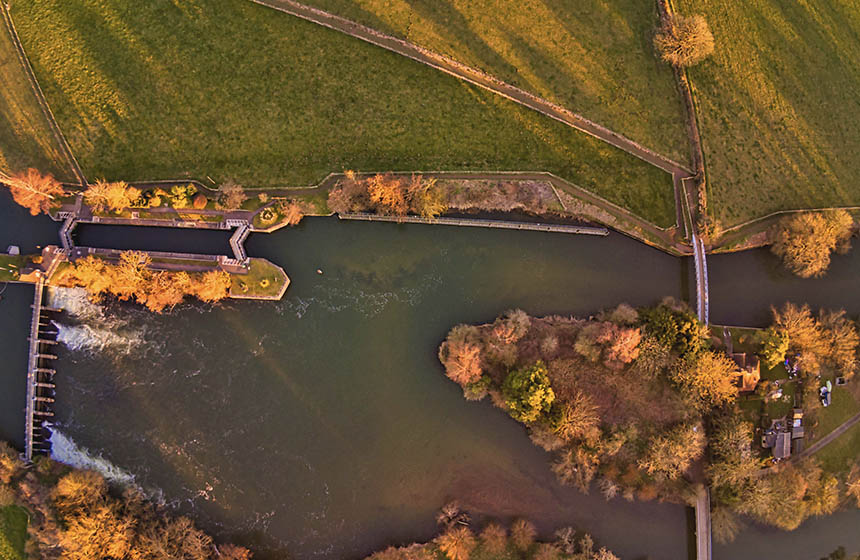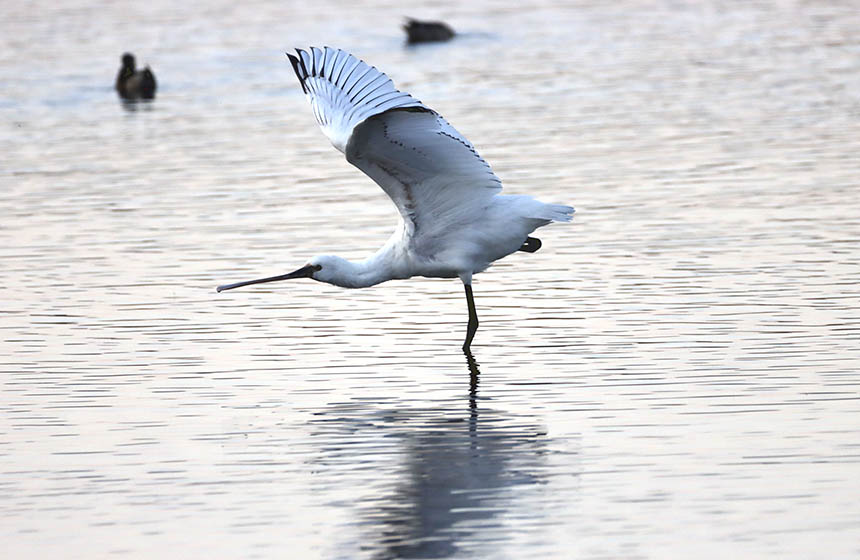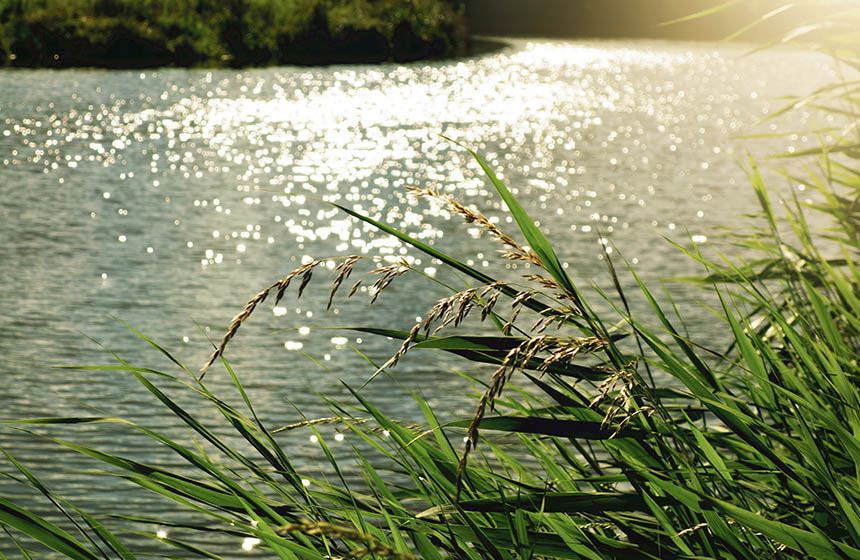River of Life: wetland restoration along the River Thames
As part of the River of Life Project from 2013 to 2022, wetland habitats were created along the River Thames and Thame to improve biodiversity, water quality, flood alleviation and carbon sequestration, with a strong focus on engaging local communities and facilitating public access to nature.
Nature-based intervention:
The River of Life projects I and II created new ponds, wetlands, meadows and wet woodland next to the River Thames and River Thame, to provide habitat for wetland species, facilitate public access and engagement, alleviate flooding downstream and enhance carbon sequestration and water quality. This involved hard landscaping to create ponds, backwaters, reedbeds and areas of fen, followed by planting reeds, restoring grassland and planting trees (1).
Overview of context and outcomes:
Sections of the Thames river were declared ‘biologically dead’ in 1950, due to water pollution. Since then, water quality has improved due to sewage treatment and some species have returned (2). However, the long-term decline in fish species has continued and other species that depend on healthy wetlands, such as yellowhammers that feed on the insect life, are still under threat. To support these priority species, the Earth Trust – a local charity – acquired 35 hectares of floodplain land adjacent to the River Thames in 2010 and partnered with the Environment Agency to implement their first wetland restoration project. Following the success of the River of Life I, the River of Life II started in 2020. There is a strong focus on participatory engagement, working closely with local landowners and the local community, and encouraging public access and interaction with nature. As well as supporting threatened species, with thousands of fish fry (young fish) using the new wetlands, the projects have also created extra flood storage capacity and aim to improve water quality and enhance carbon sequestration. Advanced techniques are being applied to monitor biodiversity outcomes and investigate crucial knowledge gaps around the balance between emissions and sequestration of greenhouse gases during construction and restoration of the wetlands. The River of Life was the joint winner of the 2014 Chartered Institute of Ecology and Environmental Management’s Best Practice Award for Practical Nature Conservation, as an example of successful wetland habitat creation.
Case effectiveness on
Climate change
The project is monitoring greenhouse gas fluxes, in order to fill knowledge gaps about the outcomes of wetland restoration projects. Wetland creation projects involve uncertainty over the extent to which emissions of methane and nitrous oxide could increase following rewetting of the soil, offsetting some of the carbon sequestration benefits. Monitoring of the River of Life II project started in 2021, so the long term outcomes have not yet been reported. However, initial monitoring indicates that constructing the wetland areas did not release the expected large flush of methane into the atmosphere, and that the rewetted areas are releasing five times less carbon dioxide per unit area than the non-wetted areas (3).
With climate change, the project area is at risk of more intense and frequent droughts and floods. It is anticipated that the project initiatives will provide resilience against these challenges by helping to regulate water supply (4). The new ponds and wetlands provide around 34,600m3 of flood storage capacity within the flood zone (1), which can help to alleviate flooding downstream. In addition, the increase in the area and quality of wetland habitats can enhance the resilience of fish and other wetland species to climate risks such as droughts and higher temperatures.
Ecosystem health
Ecological effect: PositiveThe first River of Life project aimed to convert species-poor pasture to a range of Biodiversity Action Plan habitats: wet woodland, fen, reedbed, ponds, scrapes, seasonally wet grassland, and neutral meadow. Connectivity was improved by creating a buffer around Little Wittenham Wood, a Site of Special Scientific Interest and Special Area of Conservation, and linking it to the Thames basin area. As well as providing wetland habitat for fish, the project aims to support a range of wetland-dependent priority species targeted by England’s Biodiversity Action Plan, including skylarks, yellowhammers, water voles, otters, hares, bats, great crested newts, stag beetles and club-tailed dragonflies. Monitoring revealed inadequate fish habitat before restoration, but positive impacts on fish populations and diversity were documented within a year of wetland creation. An Environment Agency survey showed fish laying eggs in the protection of the created backwaters, with hundreds of thousands of fish fry present, and 12 of the 20 fish found in the River Thames present in the project area (1). The second River of Life project was also found to increase species diversity, with the newly recorded presence of kingfishers, otters, yellow wagtails and swans within six months of habitat creation (5). The project specifically aims to increase the number of ponds to increase amphibian numbers, and increase breeding habitat for great crested newts (6).
Socioeconomic outcomes
The Earth Trust has an organisation-wide education programme, and devotes considerable effort to engaging local communities in volunteering opportunities, including planting reeds and trees, and monitoring. There is a strong focus on encouraging connections between people and nature, including political campaigning for more equal access to green space. Access to wetland ecosystems has been improved, and there are plans to create new paths, boardwalks and a viewing platform. Partners, contributors and supporters are regularly invited to visit the site.
Earth Trust’s environmental education programme engage school pupils and young people with the natural habitats across their green spaces, including wetlands, for immersive learning experiences to ignite a lifelong passion for the environment. Guided walks and special events showcase the biodiversity of different landscapes, and the importance of managing habitats for nature, people and climate.
As part of Earth Trust’s commitment to increasing access to nature’s benefits, especially for underserved communities, initiatives like the Growing Places project collaborate with local charities to provide tailored opportunities for engaging with the natural environment, supporting personal development and learning.
Overall, the River of Life projects deliver socio-economic value by creating accessible, thriving green spaces that support community health, knowledge-sharing, recreation and cohesion. Engaging people of all ages as guardians and beneficiaries of their shared natural heritage cultivates a long-term sense of connection and responsibility toward these environments.
Governance
Local participation in Governance: ActiveThe Earth Trust partners with local landowners and the Environment Agency to design and implement their wetland creation initiatives, as well as encouraging engagement by the local community.
Finance
The River of Life I project was funded primarily by the Environmental Agency, with support from Earth Trust supporters. Phase 2 of the project, which involved vegetation planting, was partly funded by Trust for Oxfordshire’s Environment (TOE2) and a Biffa Award.
The second project was funded with a Water Environment Grant through the European Agricultural Fund for Rural Development.
Monitoring and evaluation
Prior to implementing initiatives for River of Life I, site hydrology was monitored over two years via boreholes. Volunteers are involved in species monitoring.
For River of Life II, fish surveys are conducted by the Environmental Agency to record the number of species as well as fish size and age. The first of these surveys revealed 9 species and ‘healthy numbers’ of fry (7). The UK Centre for Ecology and Hydrology installed trap cameras to monitor wildlife at the River of Life II floodplain, including an innovative moth camera to record moths at night without trapping them. Carbon sequestration at the created wetlands is studied by Bangor University and the Land and Water Trust.
Trade-offs and limitations
During construction works to create ponds on farmland, farm work has the potential to be disrupted. To prevent this, the project implemented a package of mitigation measures to prevent soil compaction (4). Other risks during construction can include reducing flood storage capacity elsewhere when soil excavated from the newly created ponds is spread nearby. In this case, the Environment Agency specified that excavated soil can only be spread outside of the flood zone (8).
References
- Earth Trust. N.d. River of Life I. https://earthtrust.org.uk/what_we_do/river-of-life-1/#:~:text=One%20of%20the%20early%20successes,species%20of%20fish%20were%20present.
- Ashworth, J. 2021. Sharks, seahorses and seals found in River Thames’ first full health check. https://www.nhm.ac.uk/discover/news/2021/november/sharks-seahorses-and-seals-found-in-river-thames-first-health-check.html
- Earth Trust. N.d. Wetlands soil carbon research. https://earthtrust.org.uk/what_we_do/wetlands-soil-carbon-research/
- Earth Trust. N.d. River of Life II. https://earthtrust.org.uk/what_we_do/river-of-life-ll/
- Earth Trust. 2022. Earth Trust trustee report and financial statements. https://www.peridotpartners.co.uk/wp-content/uploads/2023/10/Earth-Trust-Financial-Statements-2021-22.pdf
- Earth Trust. N.d. River of Life II project aims. https://earthtrust.org.uk/what_we_do/river-of-life-2-project-aims/
- Earth Trust N.d. Counting fish at River of Life II. https://earthtrust.org.uk/counting-fish-at-river-of-life-2/
- Earth Trust. 2021. River of Life II FAQs. https://earthtrust.org.uk/river-of-life-construction-information-faqs/

Intervention type
- Created habitats
- Management
Ecosystem type
- Created wetland
Climate change impacts addressed
- Drought
- Freshwater flooding
Instigators
- Local NGO or CBO (eg. indigenous)
Societal challenges
- Biodiversity conservation
- Climate change mitigation
- Disaster risk reduction
- Food security
- Water security
Outcomes
- Food security: Positive
- Water security: Positive
- Health: Not reported
- Local economics: Not reported
- Livelihoods/goods/basic needs: Not reported
- Energy security: Not reported
- Disaster risk reduction: Positive
- Rights/empowerment/equality: Positive
- Recreation: Positive
- Education: Positive
- Conflict and security: Positive
- No. developmental outcomes reported: 8
Resources
Read resource 1Read resource 2
Read resource 3
Literature info
- Grey literature




